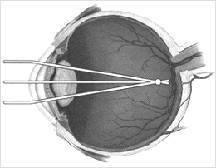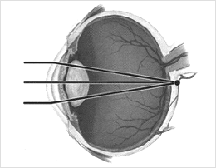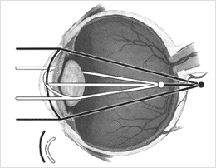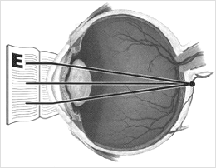|
||||
 |
||||
Types of Prescriptions |
A Refractive Error is the term used to describe your prescription. One can be near-sighted, far-sighted, have astigmatism and presbyopia. These refractive errors can occur on there own or in combination with each other. Not correcting your refractive error, through either glasses or contact lenses, could result in vision strain, blur and/or headaches.
Nearsighted (Myopia)

Conditions: Eyeball is too long or refractive power is too strong
Effect: Image is focused in front of retina
Nearsightedness, or myopia, is a vision condition in which near objects are seen clearly, but distant objects do not come into proper focus. Typically, nearsightedness occurs if your eyeball is too long, so that the light entering your eye focuses incorrectly.
Nearsightedness is a very common vision condition. Some evidence supports the theory that nearsightedness is hereditary while other evidence suggests that there is an environmental component. Children may complain of not seeing the blackboard clearly and adults may notice difficulty driving or seeing street signs. Glasses or contact lenses can be used to correct nearsightedness and may be used on a part-time or full-time basis, depending on the severity of the prescription.
Farsighted (Hyperopia)

Conditions: Eyeball is too short or refractive power is too weak
Effect: Image is focused behind the retina
Farsightedness, or hyperopia, is a vision condition in which distant objects are usually seen clearly, but close ones do not come into proper focus. Farsightedness occurs if your eyeball is too short, so light entering your eye is not focused correctly. Young children may have the focusing ability to see clearly at distance and near, but a significant strain would be placed on the focusing muscles.
Farsighted individuals often complain of difficulty in concentrating and maintaining a clear focus on near objects, eye strain, eye fatigue, headaches, and avoidance of near work. In extreme cases of far-sightedness, a child may appear to be cross-eyed. Often simply prescribing glasses can straighten the eyes, without the need for surgical intervention.
Hyperopia can be corrected with glasses and/or contact lenses.
Astigmatism

Conditions: Irregular curvature of cornea distorts refraction
Effect: Image is not focused
Astigmatism is a vision condition that occurs when the front surface of your eye, the cornea, is slightly irregular in shape. This irregular shape results your vision being blurred at both distance and near. Often the term ‘football-shaped’ verses ‘basketball-shaped’ is used to describe the shape of an astigmatic eye.
In a small portion of the population, astigmatism can be a result of an eye health problem. Some of these conditions include keratoconus, Pellucid Marginal Degeneration and cataracts. During our eye examination, tests will be performed to determine if your astigmatism is due to an eye health related concern.
Most amounts of astigmatism can be corrected with eyeglasses and/or contact lenses.
Presbyopia

Conditions: Aging of the eye causes it to lose refractive power
Effect: Image is focused behind the retina
Presbyopia is the age-related vision condition in which the lens of your eye loses its flexibility. This loss of flexibility makes it difficult to focus on close objects (i.e. reading). Thus, many individuals find that they begin to push their reading material further away.
This loss progresses over several years, but typically one becomes aware of the vision change during our early to mid-forties years. The vision change can occur more slowly or rapidly, depending on your refractive error, vision habits and genetics. It is not a disease and exercises will not reverse the aging effects.
To correct your presbyopia, we can prescribe reading glasses, bifocals, trifocals, invisible bifocals (progressive lenses) or contact lenses. There is an advantage and disadvantage to each of these corrective options. Based on your visual demands and refractive error, we will strive to prescribe the best option for your individual needs. Since the effects of presbyopia continue to change, periodic increases to your prescription may be necessary to maintain clear and comfortable vision.
Accepting new patients |
|
|
|||||



